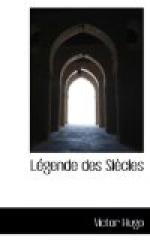The nearest approximation to the monster to be found in the pages of Cantemir is Ammath IV (r. 1623-40), of whose cruelty and bloodthirstiness the historian gives a vivid account. His principal exploit was the taking of Bagdad from the Persians, on which occasion he slaughtered 1,000 of the citizens in cold blood.
For Hugo’s conception of the power and influence of the Turkish Empire when at its zenith, see Le Rhin: Conclusion, II, III.
Liban is Lebanon.
rampantes. The word is used with the heraldic sense.
I. 19. The so-called Temple of Theseus (its real dedication is doubtful) stands on a low hill just outside Athens. It is in a state of almost perfect preservation. The nails which crowded its woodwork were doubtless those on which the heads of slaughtered Greeks were fastened. Of course in the Greek temple there was no woodwork, except possibly in the roof.
cangiar, a short Turkish sword, with an almost straight blade, having a single edge.
Naxos is an island in the South Aegean Sea; Ancyra, a town in Asia Minor.
epiques. A curious use of the word. It appears to mean `worthy of epic poetry,’ i.e. the spectres were those of great heroic men. In Les Chants du Crepuscule Hugo has ‘des grenadiers epiques’ (Napoleon II).
Elea, Megara, are towns in Greece, Famagusta is in Cyprus.
Agrigentum was a well-known Greek colony in Sicily; Fiume, at the head of the Adriatic Sea, is now an Austrian port.
Modon, a maritime town in the Peloponnesus.
Alep, Aleppo. Brousse, a town in Anatolia.
Damas, Damascus.
Tarvis (English Treviso) is a town in the province of Venice.
boyard. The boyards were the feudal nobles of Roumania and other Balkan countries.
Rhamseion, a sepulchral monument built by Ramses III, king of Egypt, in the fourteenth century B.C.
Generalife, the palace of the Moorish kings at Granada in Spain. It is scarcely necessary to say that no Turkish Sultan ever held any part of Spain.
echouait. The word is here used transitively (a rare use) in the sense of ‘drove against.’
soudan, a word of Arabic origin, was a mediaeval name for certain Mahometan princes in Egypt and Asia Minor. The word seems here loosely to designate the Turkish sultans.
turbe, a kind of small round chapel, usually attached to a mosque, in which the tombs of Sultans and other great persons are placed.
LA CONFIANCE DU MARQUIS FABRICE. (PAGE 71.)
This is the third section of a poem called L’Italie: Ratbert. The story is of Hugo’s own invention, and is intended to delineate on the one hand the savagery, and on the other the knight-errantry, of the Middle Ages.




